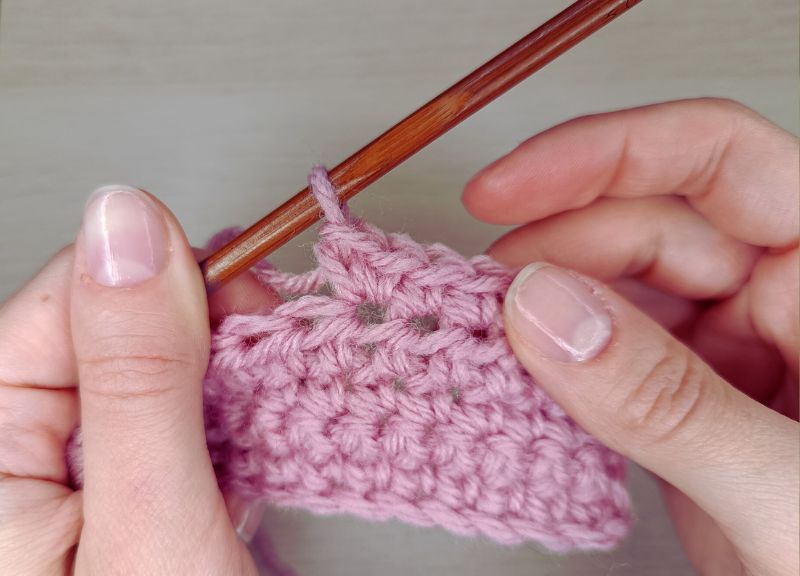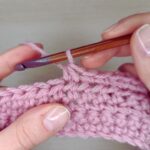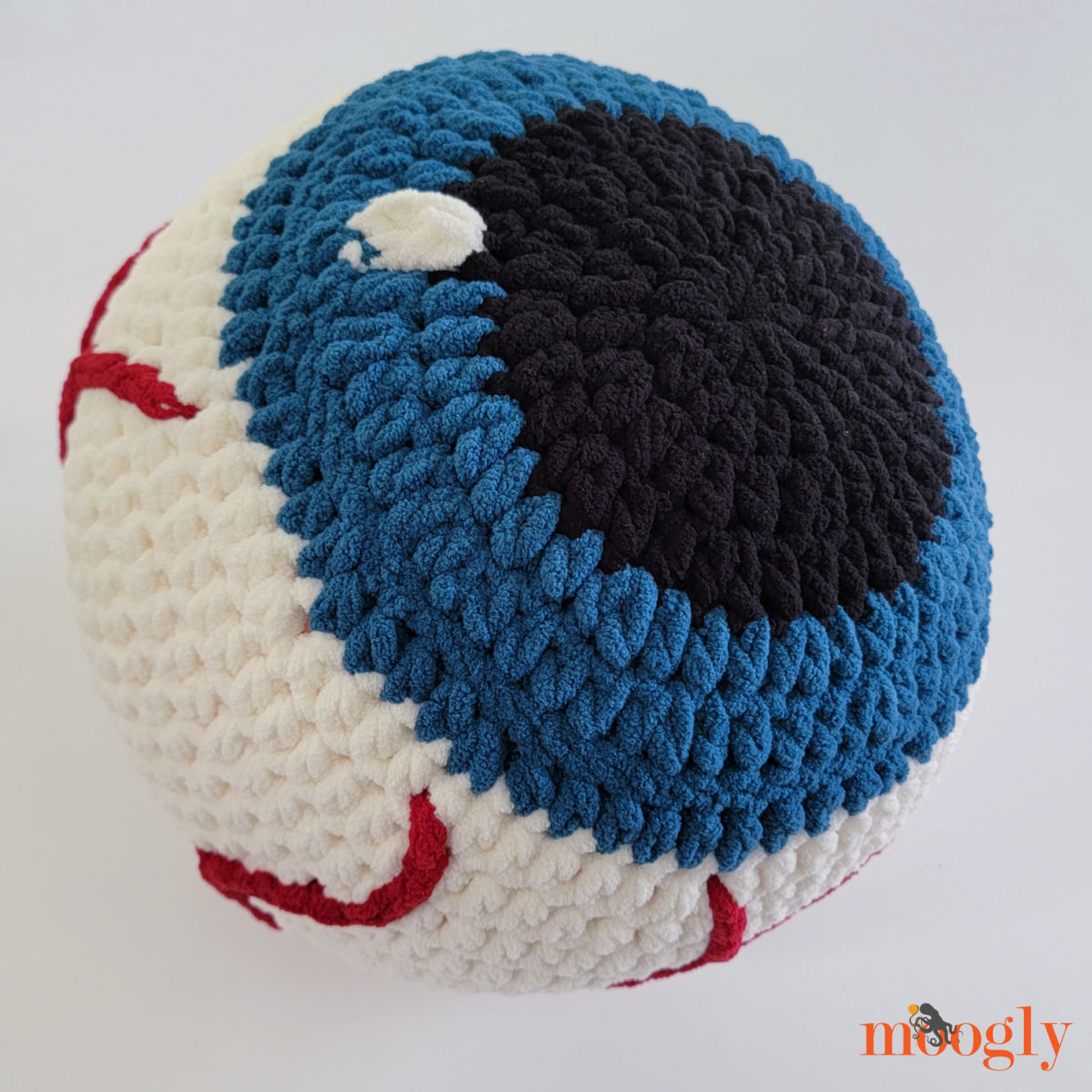What is Crochet Increase?
Crochet increase is a technique used to add more stitches to your row or round. It involves creating more stitches than the previous row, which helps shape your crochet project. By increasing the number of stitches, you can create curves and circles or add dimensions to your work. In crochet, an increase is usually denoted by working two stitches or more in the same stitch.
Mastering the crochet increase technique is important, as it allows you to control the shape and size of your project. Understanding how and when to increase stitches is crucial for creating well-defined patterns and designs in crochet.
Increasing in crochet is an essential skill for beginners to learn as it sets the foundation for more complex patterns and projects. Once you grasp the concept of increasing stitches, you can confidently tackle a variety of not easy crochet patterns and designs.
The importance of crochet increase
It’s crucial to learn how to crochet increase to create beautifully shaped projects. Whether you are working on amigurumi, garments, or accessories, knowing how to increase stitches correctly is essential to achieve the desired outcome. Proper increases ensure that your project grows evenly and maintains its intended shape.
By understanding and practicing crochet increase techniques, you can elevate the quality of your projects and take your crocheting skills to the next level. Increases also allow you to create intricate patterns and textures in your designs, adding depth and visual interest to your work.
Ultimately, the ability to increase stitches in crochet opens up a world of creative possibilities and enables you to express your unique style through your handmade creations.
Different types of crochet increases
There are various types of crochet increases that you can incorporate into your projects. Some of the common types include single crochet increase (sc inc), half double crochet increase (hdc inc), double crochet increase (dc inc), and treble crochet increase (tr inc). Each type of increase creates a different effect in your crochet work, allowing you to achieve different shapes and textures.
Advanced crochet increase techniques offer additional ways to enhance your projects, such as the invisible increase and increases within specific stitch patterns like the V-stitch or shell stitch. These stitches and techniques provide seamless and refined increases that maintain the overall look of your work.
Exploring different types of crochet increases can enhance your crochet repertoire and give you the versatility to tackle a wide range of patterns and designs with confidence.
How to Crochet Increase Tutorials
Learning how to increase in crochet is an essential skill that every crocheter should master. Below, you will find comprehensive guides that can help you understand and practice different crochet increase techniques. Whether you prefer written instructions or visual guides, there is a guideline to suit your learning style.
Video tutorials on crochet increases are particularly helpful for visual learners as they provide step-by-step demonstrations of how to execute each increase technique. Watching experienced crocheters work through the process can make it easier for you to replicate the steps and master the technique.
Basic increase techniques, such as the single, half double, double, and treble crochet increases, can be easily learned through tutorials that clearly and concisely break down each step.
Video tutorial on how to increase in crochet
A video tutorial on increasing in crochet can be a valuable resource for beginners looking to enhance their skills. Visual demonstrations offer a clear and practical guide to understanding the intricacies of crochet increase techniques. By following along with the video, you can observe the correct hand movements and yarn manipulations required to execute each increase stitch accurately.
Video tutorials often provide close-up shots of the crochet work, allowing you to see the details of each stitch formation. This visual aid can help clarify any confusing aspects of the increase technique and give you the confidence to replicate the steps on your own.
Watching a video tutorial on crochet increases can inspire and motivate you to experiment with different stitch patterns and create beautifully textured projects. You can also find a photo tutorial for increase and decrease at Yourcrochet.com.
Basic increase techniques step-by-step tutorial
Understanding basic increase techniques is essential for building your crochet skills repertoire. The increase in single crochet (sc inc) involves working 2 single crochet stitches in the same stitch, resulting in an additional stitch being added to your round or row. This simple yet effective technique is commonly used in various patterns to shape the project.
The half double crochet increase (hdc inc) and double crochet increase (dc inc) follow similar principles of adding stitches in a single stitch to expand the project’s size. These techniques are versatile and can be adapted for different project requirements, such as creating scallops or ruffles in your work.
Mastering treble crochet increase (tr inc) allows you to create elongated stitches that add height and texture to your crochet projects. By practicing these basic increase techniques, you can gain confidence in your crocheting abilities and tackle more advanced patterns with ease.
Single crochet increase stitch (sc inc)
The single crochet increase (sc inc) is a fundamental technique in crochet that involves adding an extra 1 stitch to your work. By working two single crochet stitches in the same stitch, you can increase the number of stitches in your round ot row. This technique is commonly used to shape crochet projects and create curves or angles in the design.
To execute a sc increase, insert your hook into the specified stitch, yarn over, pull up a loop, yarn over again, and complete the single crochet stitch. Repeat the process in the same stitch to create the additional stitch. Single crochet increases are essential for maintaining the structure and form of your crochet work.
Practice the single crochet increase technique to improve your crocheting skills and gain confidence in increasing stitches accurately. This skill will come in handy when working on projects that require shaping and intricate details.
Half double crochet increase (hdc inc)
The half double crochet increase (hdc inc) is a versatile technique for adding stitches quickly and efficiently to your projects. Simply work two half double crochet stitches in the same stitch, and you will create a smooth and even increase that complements the overall design. This technique is often used in patterns that require gradual shaping and dimension.
To perform a half double crochet increase, yarn over, insert your crochet hook into the specified stitch, yarn over again, pull up a loop, yarn over once more, and complete the half double crochet stitch. Repeat the process in the same one stitch to achieve the desired increase. Mastering the hdc inc technique will expand your crocheting capabilities and enable you to tackle more intricate patterns.
Experiment with half-double crochet increases in your projects to see how they enhance the overall look and feel of your crochet designs. Practice makes perfect, so keep honing your skills to become proficient in this essential crochet technique.
Double crochet increase (dc inc)
The double crochet increase (dc inc) is a fundamental technique in crochet that adds stitches efficiently to your project. By working two double crochet stitches in the same stitch, you can create a noticeable increase that adds volume and structure to your work. This technique is commonly used in patterns that require quick expansion and shaping.
To execute a double crochet increase, yarn over, insert your hook into the specified stitch, yarn over again, pull up a loop, yarn over once more, pull through two loops on the hook, yarn over, and complete the dc stitch. Repeat the process in the same stitch to achieve the desired increase. Double crochet increases are essential for creating bold and defined textures in your projects.
Practice the double crochet increase technique to enhance your crocheting skills and tackle projects that demand a rapid increase in stitches. With dedication and practice, you can master this versatile technique and use it to bring your crochet designs to life.
Treble crochet increase (tr inc)
The treble crochet increase (tr inc) is an advanced technique that adds height and texture to your crochet work. By working two treble crochet stitches in the same stitch, you can create elongated stitches that stand out in your project. This technique is commonly used in patterns that require intricate detailing and eye-catching elements.
To perform a treble crochet increase, yarn over twice, insert your hook into the specified stitch, yarn over, pull up a loop, yarn over, pull through two loops on the hook three times, yarn over, and complete the treble crochet stitch. Repeat the process in the same stitch to achieve the desired increase. Treble crochet increases are ideal for projects that call for a dramatic and textured appearance.
Mastering the treble crochet increase technique will expand your creative possibilities and allow you to experiment with different stitch heights and patterns. Incorporate treble crochet increases into your projects to add depth and visual interest to your crochet creations.
Advanced increase techniques
Advanced increase techniques in crochet offer unique ways to enhance your projects with seamless and refined increases. The invisible increase is a sophisticated method that creates a nearly undetectable increase in your work. By manipulating the stitches slightly differently, you can achieve a professional and polished look in your crochet pieces.
Increasing within specific stitch patterns, such as the V-stitch or shell stitch, provides an opportunity to incorporate increases organically into your design. These techniques blend seamlessly with the overall pattern, creating a harmonious and balanced look in your crochet work. Understanding and practicing advanced increase techniques can elevate the quality of your projects and help you achieve a professional finish.
Explore the various advanced increase techniques in crochet to broaden your skill set and add depth to your creations. By mastering these techniques, you can take your crocheting to the next level and create intricate and visually stunning pieces with confidence.
Invisible single crochet increase
By working the increases in a particular way, you can avoid the typical bump or gap that often accompanies regular single crochet increases. This technique results in a smooth and polished finish, making it ideal for projects that demand a clean and professional look.
To execute an invisible single crochet increase, carefully manipulate the stitches to create a subtle increase that blends seamlessly into the surrounding work. By paying attention to the placement and tension of each stitch, you can achieve an invisible increase that maintains the integrity of your project. Practice this technique to refine your crocheting skills and elevate the quality of your creations.
This is a valuable technique to have in your crochet toolbox, as it allows you to create flawless and well-crafted projects that showcase your attention to detail and skill as a crocheter.
V-stitch, shell stitch increases
Incorporating increases within specific patterns like the V-stitch or shell stitch can enhance the overall look and texture of your projects. By strategically placing increases within the pattern repeat, you can create intricate designs that flow seamlessly across your work. Increases in pattern add depth and dimension to your crochet pieces, making them visually appealing and unique.
The shell and V-stitches are popular patterns that lend themselves well to incorporating increases. By adjusting the placement of increases within these patterns, you can create stunning effects that draw attention to key design elements. Experiment with different stitch patterns and increases to discover new ways to elevate your projects.
Adding increases here not only enhances the aesthetic appeal of your work but also challenges you to think creatively and experiment with different techniques. Embrace the versatility of increases in pattern to create one-of-a-kind designs that showcase your skills as a crocheter.
Troubleshooting Common Mistakes
As with any skill, crocheting 2 increases may come with its fair share of challenges. Common mistakes in increasing stitches include miscounting 2 stitches, placing increases incorrectly, or working the wrong type of increase for the pattern. Identifying and addressing these mistakes early on can help prevent errors from snowballing into larger issues.
To troubleshoot common mistakes in crochet increases, double-check your stitch count regularly to ensure accuracy. If you notice any discrepancies, carefully review your work to pinpoint where the mistake occurred and make necessary corrections. Taking the time to fix errors promptly will save you from having to unravel large portions of your project later on.
Practice makes perfect in crochet, so don’t be discouraged by mistakes. Embrace them as learning opportunities that can help you refine your skills and become a more proficient crocheter. With patience and persistence, you can overcome common errors and develop a keen eye for spotting and correcting mistakes in your crochet work.
Tips and Tricks
How to Keep Track of Increases
Keeping track of increases in crochet can be challenging but essential for consistent results. Use stitch markers to mark the points where you need to increase. Another method is to use a row counter or keep a written record of each row and its corresponding increases. Some crocheters also find it helpful to count stitches frequently to ensure accuracy.
Best Practices for Even Increases
For even increases, distribute them evenly across the row or round. When working in the round, place increases at regular intervals to maintain a symmetrical shape. If working in rows, ensure that the increases are balanced on both sides to prevent your work from skewing. Regularly check your work to ensure the increases are correctly placed.
Adjusting Tension for Smoother Increases
Maintaining consistent tension is crucial when increasing stitches. If your tension is too tight, it can make the fabric stiff and difficult to work with. Too loose, and your work may become floppy and uneven. Practice adjusting your tension as you crochet, and consider using a larger hook size if your tension is too tight or a smaller hook if it is too loose.
Using Stitch Markers for Accuracy
Stitch markers are invaluable for keeping track of where to place increases, especially in complex patterns or large projects. Use them to mark the first and last stitches of each increase section. This helps ensure you don’t accidentally skip an increase and keeps your work uniform. Removable stitch markers are particularly useful as they can be easily moved as you progress.
When and Where to Use Crochet Increases
Crochet increases are used to shape your work and create specific designs. They are commonly used in amigurumi to create shapes like spheres and cones, in garments to shape sleeves and body contours, and in home décor items like blankets to create chevrons or ripples. Knowing when and where to use increases can significantly enhance the finished look of your projects.
Creating Shapes: Circles, Squares, and Amigurumi
Increases are essential for creating various shapes in crochet. For circles, increases are spaced evenly in each round to keep the shape flat. Squares use increases at the corners to maintain their form. In an amigurumi piece, increases help shape the body parts of stuffed animals and toys, making them look more lifelike and three-dimensional.
Designing Your Own Patterns with Increases
When designing your own patterns, consider how increases will affect the overall shape and structure. Plan where to place increases to achieve the desired fit and appearance. Experiment with different increase techniques to see which ones best suit your design. Keeping detailed notes will help replicate and refine your patterns.
Common Projects Using Crochet Increases (Hats, Sweaters, Blankets)
Many common projects require increases. Hats often use increases to shape the crown. Sweaters use increases for shaping sleeves and the body. Throws may use increases to create motifs like hexagons or intricate lace blanket patterns. Understanding how to properly execute increases will improve the quality and fit of these projects.
Frequently Asked Questions (FAQs)
How do I know where to place an increase?
Your pattern usually indicates the placement of increases. For example, a pattern might instruct you to “increase in the next stitch” or “make two double crochets in the next stitch.” Pay close attention to these instructions. If you design your own pattern, place increases where you need to expand the fabric, such as at the edges or in specific intervals.
What is the difference between an increase and decrease in crochet?
An increase adds stitches to your work, making it larger, while a decrease reduces the number of stitches, making it smaller. Increases are used to shape and expand, whereas decreases are used to taper and reduce. Both techniques are fundamental for shaping your makes.
Can I use increases in all basic crochet stitches?
Yes, increases can be used in all crochet stitches, including single crochet, half double crochet, double crochet, and more. The technique remains the same: work multiple stitches into one base stitch. The choice of stitch depends on the desired texture and appearance of your project.
How do I fix mistakes in my increases?
To fix mistakes in your increases, carefully unravel the stitches back to the error. Correct the mistake by reworking the section with the correct number of increases. Make sure you check everything this time. Use a crochet hook appropriate for your yarn to avoid damaging the fibers. It’s also helpful to keep a lifeline (a contrasting thread run through a row of stitches) in your work as you go to make it easier to rip back if necessary.
How to count stitches after increasing
After increasing, count the total number of stitches in the row or round, including the increased stitches. This ensures you have the correct count. Mark the beginning of each row or round with a stitch marker to make counting easier. Consistently counting stitches helps maintain accuracy and prevents mistakes from accumulating.
What is the abbreviation for increase in UK and US terms?
The abbreviation for crochet increase is the same in both UK and US terms, and it is commonly written as “inc.”
In crochet patterns, this abbreviation indicates where you need to add stitches to your work. For example, a pattern might say “sc inc in next st,” meaning you need to make two single crochet in the next stitch to increase the stitch count.
Does a magic ring use crochet increase?
Yes, it typically uses crochet increases. It is a technique used to start projects worked in the round, such as amigurumi, hats, or circular motifs. Magic circle, magic loop, or ring mean the same thing. Here’s how it involves increases:
1. Create the magic ring
The process begins by forming a loop with the yarn and working a series of stitches into this loop.
2. Work the first round
Once the initial loop is created, the first round usually involves a series of increases. For example, if you are working in a regular sc, you might start with six single crochet stitches into the ring.
3. Pull the loop tight
After the initial stitches are made, the loop is pulled tight to close the center hole, forming a neat, closed circle.
4. Subsequent Rounds
In the following rounds, increases are typically made to keep the work flat and expand the circle. For instance, the second round might involve making 2 single crochet stitches in each stitch around, effectively doubling the stitch count.
Using increases in conjunction with the magic ring method ensures a smooth, even expansion and creates a solid start for projects worked in the round.
Where could I learn how to crochet decrease?
Here at PatternCenter, of course! We have prepared a crochet decrease tutorial for you, too.
How do you follow a crochet pattern that shows an increase?
Follow these steps:
- Look for the “inc” or specific instructions indicating an increase. Patterns will often say something like “2 sc in next st” (make two single crochets in the next stitch).
- Based on the pattern, determine where the increase should be made. This is usually indicated by the stitch count or placement within a row.
- Insert your hook into the specified stitch, yarn over, and pull up a loop. Complete the required number of stitches in the same base stitch.
- After making the increase, count your stitches to ensure accuracy. The pattern will often provide the total number of stitches at the end of the round or row.
- For complex patterns, use stitch markers to keep track of where increases occur.
- Continue following the pattern instructions, repeating increases as indicated.
How to make single crochet increases?
Just follow the video tutorial or written instructions at the top of this beginner crochet guide. They will teach you how to increase in different ways!
In which patterns can you use an increase in single crochet?
You can use single crochet increases in many projects, such as:
- Amigurumi: Essential for shaping stuffed toys and figures.
- Hats: Perfect for forming the crown and ensuring a snug fit.
- Blankets: Ideal for creating circular motifs or ripple patterns.
- Garments: Useful for shaping sleeves, waistlines, and other fitted areas.
- Doilies: Great for expanding circular designs with intricate details.
- Bags: Perfect for increasing the base size.
These patterns rely on single crochet increases to shape and expand your projects as needed.
Can I use an invisible increase just for 2 stitches or more?
Invisible crochet techniques can be adapted for many basic stitches, particularly in the context of increases and decreases. However, they are most commonly used for 2 stitches: single and double crochet. Here’s how it applies to different stitches:
- Single Crochet (sc): Invisible increases and decreases are often used to create smooth, unnoticeable transitions in projects like toys and hats.
- Double Crochet (dc): Invisible decreases can be applied to reduce bulk and make the decrease less noticeable in patterns like garments and blankets.
For other basic stitches like half double crochet (hdc), invisible techniques are less commonly used but can be adapted with practice. The goal of invisible techniques is to minimize the visibility of increases and decreases, creating a smoother and more professional-looking finish.
What is a crochet increase stitch?
A crochet increase stitch is a technique for adding additional stitches in the same stitch to create a larger piece of work.
How do I crochet in the same stitch to increase one?
To increase one stitch in a single crochet, you simply crochet the first stitch as usual, then crochet another single crochet in the same stitch.
When should I make a single crochet increase in my project?
When you reach a point in your pattern where you want to widen the piece you are crocheting, you need to increase one stitch in single crochet or other basic stitches according to your pattern instructions.
Can I increase stitches in the middle of a row?
Yes, you can increase stitches in the middle of a row by working additional stitches into one stitch.
How do I crochet the first stitch of the increase?
To crochet the first stitch of the increase, simply place two stitches in one stitch to create the desired increase.
Do I need a special technique to make a single crochet increase?
Making a single crochet increase is as simple as working two or more stitches into one stitch to achieve the desired effect.
How can I practice making single crochet increases?
You can create a small crochet swatch and practice increasing stitches by working in single crochet throughout the piece.
Summary
Crochet increases are vital for shaping and adding dimension to your projects. Techniques vary, but the principle remains the same: adding stitches to expand your work. Properly placed increases result in even, attractive designs.
Practice makes perfect. Start with simple projects to build your confidence and gradually tackle more complex patterns. Regular practice will improve your technique and help you master increases.
After mastering increases, explore other techniques, such as a decrease in crochet, shaping, and pattern creation. Join crochet communities, take advanced classes, and continually challenge yourself with new projects to enhance your skills.






